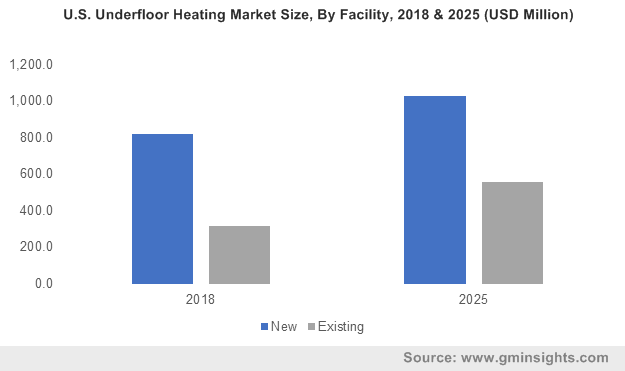Europe Underfloor Heating Market to procure modest proceeds by 2025
Publisher : Fractovia | Latest Update: 2019-06-27 | Published Date : 2017-11-03Request Sample
One of the latest trends observed across underfloor heating market in recent times is the initiative taken by various regional governments to renovate ancient buildings for promoting tourism. Furthermore, governmental bodies have framed suitable legislative norms and have also been active with regards to providing sufficient funding for the conservation of heritage buildings.
U.S. Underfloor Heating Market Size, By Facility, 2018 & 2025 (USD Million)

For instance, a few years earlier in England, the government undertook the refurbishment of the Colchester Castle in Essex and installed an all-new underfloor heating system. This initiative apparently gave rise to a substantial proportion of energy saving, as the numerous radiators had been replaced with single central heating system.
The move stimulated the demand for these systems across colder geographies, thereby augmenting the overall underfloor heating market. Lately, a lot of homeowners have also been increasingly giving preference to these heating systems, which has had a favorable impact on underfloor heating industry share.
Underfloor heating technology is increasingly trending among several house owners and builders to improve the aesthetic value and the reselling potential of buildings. Though this system requires large initial investments, it has proved to be rather cost effective later. With increasing awareness about mounting fuel bills along with shifting consumer focus toward the implementation of green technologies, the importance for energy saving facilities is growing among house-hunters.
Pertaining to the capability of such heating systems to curb the overall energy costs along with the necessity to reduce emissions, underfloor heating market size is likely to increase substantially ahead.
The UK government has lately mandated regulatory norms for implementing insulation in buildings across the United Kingdom. As per statistics, cooling, lighting, and heating systems are solely responsible for more than 50% of carbon emissions across UK, owing to which UK government, along with rest of EU countries have been looking forward to becoming carbon free in the coming fifty years.
On these grounds, regulations are being enforced on building constructions, which would prove to be a major pathway toward an emission free country and eventually, would have an impact on the regional underfloor heating market.
Speaking of the industry being governed by a stringent regulatory frame of reference, it is significant to state that regulators across Europe have launched the EU Energy efficiency directive that would help to promote the deployment of numerous sustainable heating systems. This in consequence, would have a commendable influence on the revenue scale of Europe underfloor heating industry.
Underfloor heating is on the verge of being widely accepted across European countries, owing to its advantages over conventional radiator systems. The other prominent benefits of underfloor heating systems such as flexibility, comfort, and limited maintenance are likely to enhance their adoption rate, which would considerably boost underfloor heating industry outlook over the years ahead. Another advantage that these systems have over radiators is the maintenance of moisture content in the air, owing to which their demand has gained further prominence across the globe.
Underfloor heating being one of the most suitable options to reduce the carbon emissions, is widely deployed across numerous countries, that would considerably stimulate underfloor heating industry share. In this context, it would be apt to mention that the dire need to lower carbon emissions will also drive the overall electric underfloor heating market size, slated to cross USD 2.5 billion by 2024. Reduction in the installation time and upfront cost coupled with development of flexible heating mats for small applications purposes will augment the business landscape.
Underfloor heating is also useful to reduce potential health hazards, as per analysts. Conventional heating facilities may impact negatively on people having dust allergies and asthma, on account of which most of the medical care practitioners recommend underfloor heating systems. The surging need for radiant heating systems to provide comfort will thus suitably propel underfloor heating market trends over the years ahead.
Hydronic underfloor heating systems have been gaining popularity lately, owing to their allergen free heating methodology. This is rather overt from the estimate that hydronic underfloor heating market size is slated to be pegged at USD 5 billion by 2024. It is prudent to mention that modern boilers used in hydronic heating need lots of care, as they emit comparatively more heat.
In order to meet the escalating requirement of hydronic underfloor heating systems along with the need to improve the quality and performance of boilers, renowned giants in underfloor heating industry are investing heavily in research and development activities. Speaking of which, Uponor Corporation, Siemens, Robert Bosch, Sensata Technologies, Honeywell International, REHAU corporation, Schneider Electric, Emerson Electric, Mitsubishi, Pentair, Danfoss, Hunt Heating, Nexans, WARMUP Plc, H2O Heating, and Amuheat are few of the well-known players in underfloor heating market.